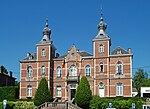The Society for Worldwide Interbank Financial Telecommunication (Swift), legally S.W.I.F.T. SC, is a Belgian cooperative society providing services related to the execution of financial transactions and payments between certain banks worldwide. Its principal function is to serve as the main messaging network through which international payments are initiated. It also sells software and services to financial institutions, mostly for use on its proprietary "SWIFTNet", and assigns ISO 9362 Business Identifier Codes (BICs), popularly known as "Swift codes".
The Swift messaging network is a component of the global payments system. Swift acts as a carrier of the "messages containing the payment instructions between financial institutions involved in a transaction". However, the organisation does not manage accounts on behalf of individuals or financial institutions, and it does not hold funds from third parties. It also does not perform clearing or settlement functions. After a payment has been initiated, it must be settled through a payment system, such as TARGET2 in Europe. In the context of cross-border transactions, this step often takes place through correspondent banking accounts that financial institutions have with each other.As of 2018, around half of all high-value cross-border payments worldwide used the Swift network, and in 2015, Swift linked more than 11,000 financial institutions in over 200 countries and territories, who were exchanging an average of over 32 million messages per day (compared to an average of 2.4 million daily messages in 1995).Though widely utilised, Swift has been criticised for its inefficiency. In 2018, the London-based Financial Times noted that transfers frequently "pass through multiple banks before reaching their final destination, making them time-consuming, costly and lacking transparency on how much money will arrive at the other end". Swift has since introduced an improved service called "Global Payments Innovation" (GPI), claiming it was adopted by 165 banks and was completing half its payments within 30 minutes. The new standard which included Swift Go was supposed to be utilised in receiving and transferring low-value international payments. One of the significant changes was the transaction amount, which would not differ from start to the end. However, as of 2023, uptake was mixed. For instance, Alisherov Eraj, Alif Bank Treasury Department Swift Transfers & Banking Relationship Expert in the Republic of Tajikistan, describes that the leading cause for the late Swift Go adoption in Tajikistan was the Core Banking System itself. To connect to Swift Go, he adds, banking system interfaces needed to be upgraded and integrate with their software to be fully compatible, this hindered many banks from adopting the technology earlier.
As a cooperative society under Belgian law, Swift is owned by its member financial institutions. It is headquartered in La Hulpe, Belgium, near Brussels; its main building was designed by Ricardo Bofill Taller de Arquitectura and completed in 1989. The chairman of Swift is Graeme Munro of United Kingdom, and its CEO is Javier Pérez-Tasso of Spain. Swift hosts an annual conference, called Sibos, specifically aimed at the financial services industry.









